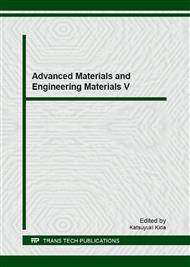p.224
p.230
p.237
p.242
p.246
p.251
p.256
p.261
p.267
Surface Modification of Nano-Al2O3 with Stearic Acid
Abstract:
Surface modification of nanoAl2O3 with stearic acid by dry method was researched. The structures of nanoAl2O3 before and after modified were characterized by IR. The modification effect on nanoAl2O3 was measured with the activation index. In addition, the influence factors of modifier dosage, modification time and modification temperature were also discussed. The results showed that nanoAl2O3 had been successfully modified with stearic acid. The hydrophily and lipophilicity experiments indicated that modified nanoAl2O3 possessed lipophilicity property and could disperse in xylene. The optimal conditions of modification were as follows: the stearic acid was 7.5 wt%, based on the quality of nanoAl2O3, modification time was 50 min and temperature was 150 ○C.
Info:
Periodical:
Pages:
246-250
Citation:
Online since:
August 2016
Authors:
Keywords:
Price:
Сopyright:
© 2016 Trans Tech Publications Ltd. All Rights Reserved
Share:
Citation:


